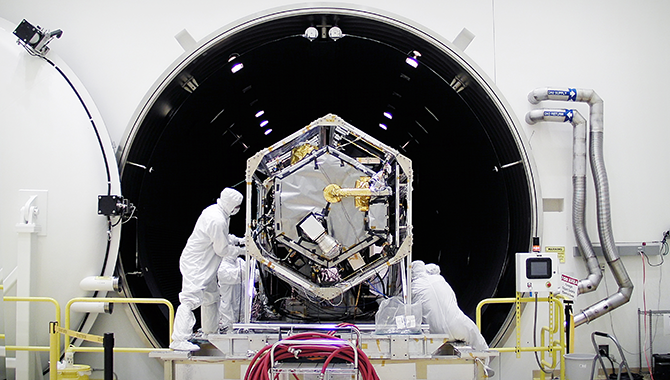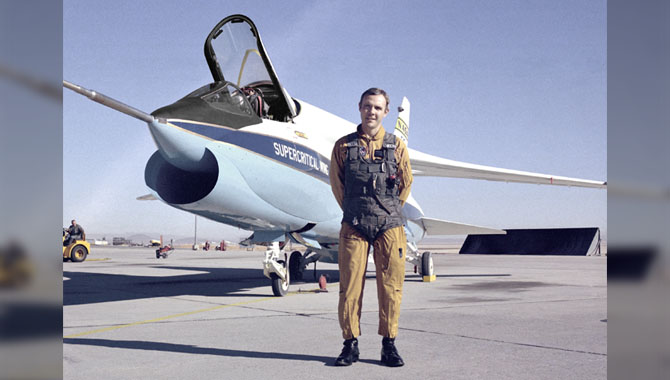
Phase one of NASA’s High Alpha Technology Program (HATP) included visual studies of airflow along different parts of the aircraft. In this image, the High Alpha Research Vehicle (HARV) is at a high angle of attack, with tracer smoke indicating vortex flows along the leading edge extension.
Photo Credit: NASA
Twenty-five years ago this month, NASA redefined aircraft maneuverability and control with the first flight of a vehicle featuring a thrust-vectoring control system (TVCS).
For aircraft—military fighter planes in particular—maneuverability is critical. One way to enhance maneuverability is to maintain a high angle of attack, also known as high alpha, in which the pilot increases the angle between the aircraft’s forward direction (flight path) and the point where the air flow hits the center of its wings. But the high angle of attack comes at a price: as lift and drag increase, so does the aircraft’s potential to stall.
Industry, academia, and government agencies, including NASA and the Department of Defense (DoD), sought to extend the high angle-of-attack envelope: to reduce the likelihood of stalling at increasingly high angles of attack in order to enhance performance and control. In response to this need, NASA initiated the High Alpha Technology Program (HATP): a three-phase initiative that ran from April 1987 to September 1996 and involved all four agency aeronautical centers. Ames Research Center (ARC) contributed computational fluid dynamics and research in its 80-foot by 120-foot wind tunnel. Langley Research Center (LaRC) conducted sub-scale wind-tunnel testing and looked at advanced control law synthesis and computational fluid dynamics. Lewis Research Center (LRC, now Glenn Research Center (GRC)) explored inlet and engine integration. The full-scale flight research took place at Dryden Flight Research Center (DFRC, now Armstrong Flight Research Center (AFRC)) using a McDonnell Douglas F/A-18 Hornet fighter aircraft powered by two modified General Electric F404-200 engines, each producing 1,600 pounds of thrust. The aircraft, known as the High Alpha Research Vehicle (HARV), was extensively modified for phases two and three of the program.
Phase one of the HATP lasted from 1987 to 1989 and explored the aerodynamics of high angle-of-attack flight. Researchers conducted visual studies of the airflow over different parts of the HARV during flight. To do this, they employed three different techniques—tracer smoke, tufts of yarn, and dye-laden antifreeze—that were captured via on-board video and still cameras to visualize the movement of the air around the plane. As the smoke, yarn, and liquid shifted around the aircraft, they were able to see the behavior of the airflow. These findings were then compared with wind-tunnel test results.
Using this information, the team modified the HARV for phase two, which examined the utility of thrust vectoring to produce enhanced maneuverability and control at high angles of attack. The HARV was equipped with a novel multi-axis TVCS consisting of three vanes, or paddles, that were installed around each engine. The vanes, made of a heat-resistant nickel alloy containing chromium and iron, were placed around each engine’s exhaust in order to affect the pitch and yaw of the aircraft by changing the direction of the exhaust flow. The TVCS added significantly to the aircraft’s weight, increasing it by 2,200 pounds and altering the aircraft’s performance.
Several other modifications were performed for phase two, including installation of battery-operated emergency backup systems. In addition, a research flight control system (RFCS) consisting of a PACE 1750A computer and unique flight control laws was added, which allowed the pilot to push the aircraft to achieve the program’s research objectives. The original F-18 computer control system was used for takeoffs and landings.
The first flight of the TVCS-enhanced HARV took place on July 15, 1991. NASA research pilot Edward T. Schneider was at the controls. Schneider, along with William H. (Bill) Dana, was co-pilot for the nine-year program. Over the course of phase two, from 1991 until mid-1994, Schneider, Dana, and several guest pilots manipulated the exhaust flow on the HARV with outstanding results. During an expanded envelope segment of phase two, they achieved stable flight at a 70-degree angle of attack, something not managed at more than 55 degrees in the past, and performed controlled rolling in flight at a 65-degree angle of attack, which had not been possible previously at over 35 degrees. In addition, the pilots were able to maintain a high angle of attack for longer than was possible without the TVCS. Altogether, 193 flights were conducted during phase two.
The HARV went on to phase three of the HATP, which looked at forebody vortex control as an additional means of gaining maneuverability without sacrificing stability. In the end, the program demonstrated stabilized flight at angles of attack between 60 and 75 degrees. These findings improved the handling and maneuverability of aircraft, enabling safe flight during the most dangerous part of a flight envelope, which pilots previously had to avoid. Over the nine years of its operation, 385 research flights were conducted during the HATP. The HARV was retired after the program and is on display at the Virginia Air & Space Center in Hampton, VA.
Learn more about the HATP and HARV in NASA Technical Memorandum 4772, An Overview of the NASA F-18 High Alpha Research Vehicle.
Watch a video showing highlights of the HATP flight research, including lateral agility rolls.
View a video of thrust vectoring as demonstrated during wind-tunnel testing at LaRC.









